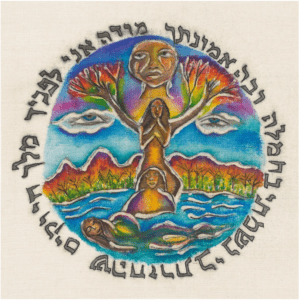
Aimee Orkin’s batik on raw silk is titled “Modeh Ani Lefanecha, Thank you God for a new day!”
Apiece of art can evoke an array of emotions and a variety of interpretations from different people, but one thing is clear: art appeals to nearly everyone, uniting people of various cultures and religions. This common thread was the artistic force behind a current virtual exhibit called Visual Prayer. Parts of the exhibit feature the inspiration of 19 women artists from several different religions, 10 of whom are Jewish artists.
“Visual prayer is the creative exploration and expression of prayer through images and possibly with text,” said Aimee Orkin, who conceived the collaborative project “Interfaith Prayer Wall,” a mural that is on display through the end of April at the Hoedeman Gallery of Sacred Art at the Iversen Center for Faith located at the University of St. Thomas.
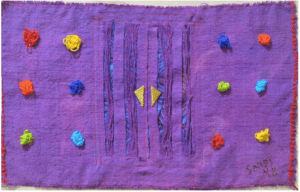
Sandy Baron’s “Tabernacle, Tents and Tribes” is dyed raw silk with screen printed cotton and embroidery threads.
The Interfaith Prayer Wall, a piece in the Visual Prayer exhibit, is a 6-foot-by-9-foot canvas painted in ochre golds like the ancient limestone of the Jerusalem walls. Affixed to the canvas are various individual art pieces created by several artists who used a variety of mediums. They include paper cut and acrylic paintings on silk and canvas to embroidered linen, beaded quilt, as well as drawings in marker, gel pens, and watercolors. Several artists affiliated with either Judaism, Christianity, Islamic faiths or other spiritual paths thoughtfully created each piece pulled together in this architectural mural display.
“This wall is a place we unite to create hope, beauty and spirituality,” said Orkin, a member of the Interfaith Artist Circle who took a sabbatical from her position as an art specialist at the Heilicher Minneapolis Jewish Day School. “By exhibiting together in our Interfaith Artist Circle, our goal is to find commonality and connectivity among religions and to appreciate and respect our similarities and differences in belief and self-expression.”
A Safe Place for Discussion
Jewish member Sandy Baron, who contributed to the prayer wall a dyed raw silk piece with embroidery threads titled “Tabernacle, Tents and Tribes,” recounted how “the Interfaith Artist Circle has provided a safe space for open interaction and discussion about our different religions and customs.” She added, “It is interesting to always see how each artist produces a unique piece after studying the same theme.”
Another one of Baron’s pieces on display in the Visual Prayer exhibit is “Windows into Prayer,” which is a wall hanging she wove using a floor loom. “I was inspired by the colors described in Exodus 26:36 in the building of the Tabernacle,” she said. “The windows are created by the shapes I designed in the weaving, some windows are more open than others.”
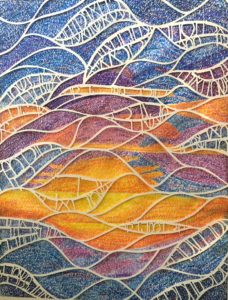
Rani Halpern created “Prayers of the Soul” using acrylic brush markers and cut paper.
One piece, “Prayers of the Soul,” created by Rani Halpern, is a combination of paper cutting and acrylic brush markers. It consists of prayers from the morning Shacharit daily service.
“I have really enjoyed being a part of this interfaith art group and learning about the commonalities and the differences in our approaches to prayer,” said Halpern. “It really has helped my understanding and appreciation of prayer.”
Artist Gloria Cooper, who has two related pieces called “Grow, Grow” in the exhibit, added that “It is very enriching and rewarding to see everyone’s different takes on their own beliefs and religion and how we have much more in common than we expected.”
Cooper added that her piece on the art wall, which uses golds, blues and greens, as well as Hebrew lettering, reminds us that “the world was created for us with intention” right down to how “every blade of grass has its own angel that bends over it and whispers ‘grow, grow’ — a passage from the Talmud.”
A Vibrant, Diverse Community
The University of St. Thomas, the largest Catholic university in Minnesota with campuses in St. Paul and Minneapolis, is one of a few stops for the Visual Prayer exhibit. From May to August 2020, the Sabes JCC held a virtual exhibit — the online gallery is still visible. But it was important to St. Thomas to physically hang interfaith works on the walls of its newly constructed Hoedeman Gallery of Sacred Art, in addition to showcasing the fuller virtual works.
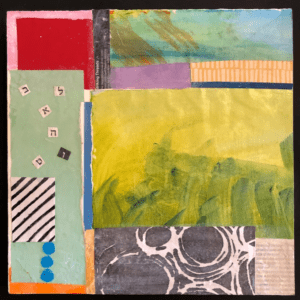
Gloria Cooper’s art piece “Grow, Grow” is inspired by the Talmud passage: “Every blade of grass has its own angel that bends over it and whispers ‘grow, grow.’”
“Within the arts, individuals share in God’s creative work,” said Father Lawrence Blake, the university’s director of campus ministry, adding that “One of the University of St. Thomas’ core convictions is to create a vibrant, diverse community.”
Father Blake said the Visual Prayer exhibit came to campus in part because of the coordination of David Harris, who is both the executive director of Rimon: The Minnesota Jewish Arts Council and the interfaith arts special consultant at the Jay Phillips Center for Interreligious Studies, housed at the university. The Jay Phillips Center is a co-sponsor of the virtual exhibit and of the recently held artist salon.
“One of the big successes of this project was the way in which we were able to embed it in numerous departments at the University of St. Thomas,” said Harris, who co-curated the virtual exhibition with Deborah Ultan, the arts and design librarian at the University of Minnesota. Together they organized the artwork of the Visual Prayer exhibit under six rubrics: Blessings, Meditations, Passages, Petitions, Songs of the Earth, and Teachings. These areas give the viewer the experience of walking into six galleries, he said.
In addition to exhibiting in the Hoedeman Gallery of Sacred Art, the Interfaith Prayer Wall and the online exhibit were also a part of the Sacred Arts Festival, which produced the artist salon, and held a few student and staff workshops led by Orkin. “I’m particularly pleased that the salon’s robust attendance is drawing attention to the online exhibit,” Harris said.
Also pleased are the artists. Other Jewish contributors to the exhibit are Lucy Rose Fischer, Anita White, Sandra Brick, Jane Bassuk, Paula Pergament, Rochelle Woldorsky and Joyce Lyon. They are all members of The Interfaith Artist Circle, which was formed in 2015 as an offshoot of the Jewish Women’s Artists’ Circle.
A Reflection of Modern Feminism
The Jewish Women’s Artists’ Circle was co-founded by Fischer about 15 years ago. “I was only at the beginning of my art career when another artist and I started this project,” said Fischer. “We had a theme — we wanted each artist to create a work that reflects modern feminist views of Judaism. We got a small grant from Rimon, the arts council of the Minneapolis Jewish Federation, and we invited artists to apply to be in the group.”
The circle was supposed to last for one year, with an exhibit at the end of the year, but the artists wanted to continue their meeting and collaborating. And so they did.
Each year, the women choose new spiritual themes: the soul, mysticism, creation, repair. They invite scholars, religious and secular, to teach and inspire them.
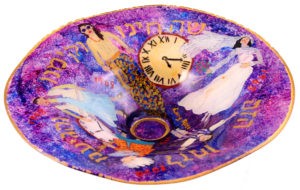
Artist Lucy Rose Fischer created a glass bowl titled “Shechechiyanu” after the traditional prayer of gratitude.
“Just before our first meeting, I went to an exhibit of the St. John’s Bible at the Minneapolis Art Institute. This was the first illuminated Bible in 500 years,” said Fischer. “I was intrigued by the fact that all the artists studied with scholars before they painted their beautiful illustrations of the text. I thought: ‘that’s what we should do with our group: we should study.’”
As a group, they had exhibits all over the Twin Cities in churches, synagogues and traditional galleries. Then, six years ago, they decided to invite several Christian women artists to join for an interfaith exhibit. This also was supposed to be just for one exhibit. “The problem was—we liked those artists, we appreciated the diversity of perspectives, and we didn’t want them to leave,” Fischer explained.
The invited artists from different faiths who have since joined them for this interfaith community-building bring a diverse representation, including, but not limited to, Catholic, Muslim, Buddhist, Protestant, Unitarian, Quaker, Universalist, and transcendental. They include the artworks of Jeanne Aaron, Hend Al-Mansour, Beth Andrews, Jane Bassuk, Kirsten Malcolm Berry, Elizabeth Erickson, Angela Heida, Susan Peploe, Regula Russelle, and several others.
“This has been a profound opportunity to learn from one another about our faiths and our spiritual journey,” said Fischer, who created a glass bowl titled “Shechechiyanu” after the traditional prayer of gratitude — it is featured in the current exhibit. “I have lived a long time and have experienced much to be grateful for — not just the big events, but the many ordinary times of my life,” she added.
“As a Jewish artist, working on the theme ‘Visual Prayer’ with our Interfaith Artist Circle has been particularly meaningful,” said Fischer. “Leading this group has been an honor and a wonderful experience for me. I’m continually amazed by the art, creativity, and wisdom of my fellow artists.”
Sheree R. Curry, a long-time Jewfolk Inc. board member, is a Twin Cities-based freelance journalist and the director of communications at the University of St. Thomas. Follow her on Twitter.

